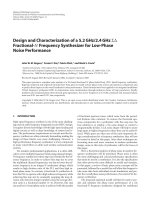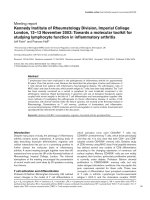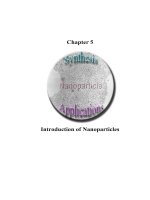Synthesis and characterization of group 11, 12 and 13 metal selenocarboxylates potential single molecular precursors for metal selenide nanocrystals 2
Bạn đang xem bản rút gọn của tài liệu. Xem và tải ngay bản đầy đủ của tài liệu tại đây (14.93 MB, 45 trang )
Chapter 5 Introduction to NPs
78
Chapter 5. Introduction to Nanoparticles
5.1 General Introduction
About half a century ago, Richard Feyman gave his prophetic lecture “Plenty
of Room at Bottom.” He outlined in this talk the foundations of nanoscience, and the
promise that totally synthetic constructions could eventually be built with molecular
scale precision. Nanoscience research has been rapidly increasing across the globe
during the past decade. It is now widely accepted by the scientific, industrial,
government and business communities, that nanoscience will be integral importance
in the development of future technologies. Nanoscience is being touted as the engine
that will drive the next industrial revolution.
NPs, are referred to particles with size ranges from 1 to 100 nm in diameter.
Meanwhile, NC is referred to single crystal with size of 1 to 100 nm. In this thesis, we
are using the term “nanosynthesis” to describe the synthesis that product NP. Usually
the properties of crystalline solids are ordinarily catalogued without reference to their
size. It is only in the regime below 10 nm, called Quantum Dots (QDs) where this
variable comes into play. Independent of large number of surface atoms, NCs with the
same interior bonding geometry as a known bulk phase often exhibit strong variations
in their optical and electrical properties with size.
1, 2
These changes arise through
systematic transformations in the density of electronic energy levels as a function of
size of the interior, known as quantum size effect, which pointed out that NCs are lie
in between the atomic and molecular limit of discrete density of electronic state and
the extended crystalline limit of continuous bands. Clearly shown in Figure 5.1, NPs
contain discrete and large “molecular-like” electronic states and their HOMO –
Chapter 5 Introduction to NPs
79
LUMO gap widen with decreasing the particle size. Therefore band gap of NPs can be
tuned by changing the particle size.
3
Figure 5.1. Schematic illustration of the density of states, along with the changes in
the band gap, in semiconductor clusters.
3
In the past decade, enormous range of physical properties afforded by size-
tuning of semiconductor NCs, a class of materials with so many established
applications in electronics, optics, and sensors, has drawn the attention of scientists
from diverse disciplines, from synthetic and physical chemists to materials scientists,
condensed matter physicists, and electrical engineers. Recent years, the ability to
control the surfaces of semiconductors with near atomic precision has led to a further
idealization of semiconductor structures: quantum wells, wire, and dots. Such
structures should exhibit the idealized variations in density of electronic states
predicted by simple particle in a box type model of elementary quantum mechanics,
with the continuous levels of the 3d case evolving into the discrete states of the 0-
dimensional case as shown in Figure 5.2.
4
Chapter 5 Introduction to NPs
80
Figure 5.2. Idealized density of states for one band of a semiconductor structure of 3
– 0 dimensions.
4
5.2 Applications of NPs
Colloidal NCs are sometimes referred to as ‘artificial atoms’ because the
density of their electronic states – which controls many physical properties – can be
widely and easily tuned by adjusting the crystal’s size and shape. The combination of
size- and shape-dependent physical properties and ease of fabrication and processing
makes NCs promising building blocks for materials with designed functions.
5, 6
In the
following section, we will present several applications associated with semiconductor
NCs and nanostructure engineering.
5.2.1 Luminescence
Narrow band (15–20 nm), size-tunable luminescence, with efficiencies at least
of order 10%, is observed at room temperature form semiconductor NCs. The origin
of this luminescence remains the topic of some controversy.
7-9
As the size is reduced,
the shift between the absorbing and emitting state is observed to increase. Therefore
different emission wavelengths could be obtained in principle by changing the particle
size, a well known example will be the CdSe NPs as shown in Figure 5.3.
10
Chapter 5 Introduction to NPs
81
Independent of the exact origin of the luminescence, it does appear to be one property
which can be manipulated in useful ways. For example, Korgel and co-workers found
that the absorption edge of Si nanowires was significantly blue-shifted as compared
with the indirect band gap (~ 1.1 eV) of bulk silicon.
11-13
They also observed sharp,
discrete features in the absorption spectra and relatively strong “band-edge”
photoluminescence. They suggested these optical features most likely originated from
quantum confinement effects, although surface state might also make additional
contributions.
14
Figure 5.3. Room-temperature emission (left) and absorption (right) spectra taken
from difference sizes CdSe NPs.
10
5.2.2 Biological Labeling
Now days, the QDs are widely employed as targeted fluorescent labels in
biomedical research applications due to the quantum size effect of the NPs as
discussed in earlier.
15-17
A chart as shown in Scheme 5.1 illustrated the applications of
QDs as multimodal contrast agents in bioimaging. Compared with the organic
Chapter 5 Introduction to NPs
82
fluorophores that were previously used as biological labels, QDs do not photobleach.
Studies have shown that only very small amount of QDs is required to produce a
strong signal. Indeed, several studies have reported flickering of some specimens, a
phenomenon due to the blinking of a small number of QDs.
18, 19
This demonstrates
that single QDs can still be observed in immunocytological conditions, with an
ultimate sensitivity limit of one QD per target molecule. In addition, NPs also provide
a readily accessible range of colors. Recently, different-sized QDs have been
embedded into polymeric microbeads at precisely controlled ratio to achieve
multicolor optical coding for biological assays.
20
Scheme 5.1. Applications of QDs as multimodal contrast agents in bioimaging.
17
Chapter 5 Introduction to NPs
83
5.2.3 Light Emitting Diodes
Alivisatos et al. and Bawendi et al. are the first research groups demonstrated
that light-emitting diodes can be made with polymers and CdSe NCs.
21, 22
As
previously discussed in section 5.2.1, the NCs emission shift with size. Thus, the
output color of NC LEDs can be tuned by varying the particle size as shown in Figure
5.4. In certain electronic devices, the semiconducting polymers can replace the
inorganic semiconductors due to the low processing cost, for instance, organic light-
emitting diodes (OLED). The extension of OLEDs into the technologically important
near-infrared (NIR) spectral range used in telecommunications is more difficult
because organic molecules usually display optical activity only at wavelengths shorter
than 1 µm. However this shortfall is overcomed by Banin’s group where they created
a near-infrared plastic light-emitting diodes using a conjugated polymers and InAs-
ZnSe core shell type of NP.
23
Figure 5.4. True color image of CdSe NPs illuminated with UV light. (Image was
taken from
5.2.4 Laser
Unlike the spherical dots, quantum rods have linearly polarized emission as
demonstrated recently by fluorescence measurements on single quantum rods and by
Chapter 5 Introduction to NPs
84
theoretical calculations.
24
This property of linearly polarized emission, along with the
prospect of broad spectral coverage and the chemical accessibility to quantum rods,
renders them highly attractive as potential laser materials. Recently, an amplified
spontaneous emission was observed for spherical colloidal CdSe QDs in close-packed
films where pumping with an amplified femtosecond laser source was used to
compete with fast non-radiative Auger decay processes.
25
Banin’s group have also
observed lasing from CdSe/ZnS quantum rods.
26
In their study they observed a
linearly polarized lasing signal from the quantum rods and a non polarized lasing
from QDs (as shown in Figure 5.5) which prove the advantageous for the utility of the
rods as laser chromophores. Further, the Auger rates in rods may be smaller because
of their larger size while still allowing color tunability through control of the rod
diameter.
Figure 5.5. Polarized emission measurements for lasing in (a) NCs and (b) NRs.
26
5.2.5 Solar Cell
Charge transfer rate is reported to improve the efficiency of polymer
photovoltaic devices.
27
A faster charge transfer rate can be achieved by chemically
bind the organic molecules to the nanocrystalline and bulk inorganic semiconductors,
which have a high density of electronic states.
28
Alivisatos and his co-workers have
Chapter 5 Introduction to NPs
85
demonstrated this concept by showing that CdSe NRs can be used to fabricate readily
processed and efficient hybrid solar cells together with conjugated polymer poly(3-
hexylthiophene).
29
The intrinsic features and thus performance of such a device could
be tuned by controlling the aspect ratios of the NRs. They also found that NRs were
superior to QDs in photovoltaic applications, because they can provide a direct path
for electrical transport at much lower loadings. The fabricated photovoltaic device
eventually achieved an external quantum efficiency of over 54% and a
monochromatic power conversion efficiency of 6.9% under 0.1 milliwatt per square
centimeter illumination at 515 nanometers.
5.2.6 Sensing Applications
The extremely high surface-to-volume ratios associated with the
nanostructures make their electrical properties extremely sensitive to species adsorbed
on surface. Tao and co-workers have demonstrated this concept using arrays of Cu
nanowires that contained nanoscale gaps generated through an automated
electrochemical process.
30
Upon adsorption of organic molecules onto these
nanowires, the quantized conductance was reduced to a fractional value as a result of
scattering of conduction electrons by the absorbates. Another demonstration, Penner
and co-workers fabricated hydrogen sensors with Pd nanowires supported on the
surface of a polymeric thin film as shown in Figure 5.6.
31, 32
The resistance of these
nanowires varied upon the adsorption of hydrogen molecules. In addition to metal
nanowires, Lieber and co-workers have implemented the surface modified
semiconductor nanowires as highly sensitive, real time sensors for pH and biological
species.
33
Chapter 5 Introduction to NPs
86
Figure 5.6. (A) Schematic diagram of a platinum mesowire array-based hydrogen
sensor or switch. (B) SEM image [400 mm(h) by 600 mm (w)] of the active area of a
platinum mesowire array-based hydrogen sensor.
31, 32
5.3 Synthesis of Nanomaterials
Vast applications of nanomaterials as discussed in the previous section have
prompted intensive study of the synthesis of these materials to optimize colloidal
semiconductor NCs fabrication. As a result, many new concepts for controlling the
size, shape, aspect ratio (
Diameter
Length
) and connectivity or coupling of colloidal
NCs have been developed first for metal chalcogenide materials, but a unified set of
synthesis control concept is now also being applied to other classes of materials, such
as metals and metal oxides. After more than two decades, impressive progress has
been made towards the tailored synthesis of colloidal NCs that have well-defined
structures. A wide variety can now be successfully produced using a number of
methods, such as coprecipitation, microemulsion, hydrothermal/solvothermal
synthesis and surfactant-controlled growth in a hot organic solvent using either single
or multi-source precursors.
34, 35
Chapter 5 Introduction to NPs
87
5.3.1 Coprecipitation Synthesis
Many of the earliest syntheses of NPs were achieved by the coprecipitation
method which involves the simultaneous occurrence of nucleation, growth,
coarsening and agglomeration processes. Due to the difficulties in isolating each
process for independent study, the fundamental mechanisms of this technique is still
not thoroughly understood. The theory of coprecipiration has been discussed in
numerous of books and reviews.
36-41
Reaction conditions that influence the mixing
process, such as rate of reactant addition and stirring rate, must be considered relevant
to product size, morphology, and particle size distribution. The reduction of gold
cation to gold metal is the most thoroughly studied metal precipitation reaction. Gold
cations, usually in the form of AuCl
4
-
are easily reduced by gaseous H
2
. Although
AuCl
4
-
is strong oxidizing (E˚ = +1.022 V) that weaker reducing agents such as
carboxylates or alcohols are usually sufficient.
34
Tan et al. have recently reported the
synthesis of Au, Pt, Pd and Ag NPs by reduction with potassium bitartrate as shown
in Figure 5.7. All the products formed stable colloids with the addition of a suitable
stabilizing agent.
42
Normally a stronger reducing agent, such as borohydride, is
needed to reduce the AuCl
4
-
in a thiol containing solution. This is due to the
complexes formed between the thiols and AuCl
4
-
are too strong to be reduced by weak
reducing agent e. g., citrate. However, Yonezawa et al. have demonstrated that
reduction of AuCl
4
-
with citrate in the presence of a thiol is possible, if the thiol and
citrate are added to the the gold solution simultaneously.
43
Gold colloids with 2 – 10
nm dimensions and narrow size distributions are achievable with this method.
The stabilization of Au NPs against agglometation in aqueous solutions by
capping ligands such as citrate is a well-documented process. Brust et al., however
reported the synthesis of alkanethiol stabilized colloidal Au NPs that are stable in
Chapter 5 Introduction to NPs
88
noNPolar solvents. Moreover, the particles exhibited rather unusual ability to be fully
redispersed into colloids after being isolated as dry powders.
44, 45
The two-phase
coprecipitation synthesis introduced by Brust et al. have triggered a flurry of research
into the thiol-based stabilization of colloidal NPs.
34
Figure 5.7. TEM images of poly(N-vinyl-2-pyrrolidone) capped (a) Au and (b) Pt
NPs.
42
5.3.2 Microemulsion Synthesis
Hoar and Schulman noted in 1943 that certain combinations of water, oil,
surfactant, and an alcohol- or amine-based cosurfactant produced clear, seemingly
homogeneous solutions that Schulman termed “mircoemulsion”.
46
Based on their
finding, two scenarios can be generated, oil-swollen micelles dispersed in water (oil-
in-water microemulsion) or water-swollen micelles dispersed in oil (inversed
microemulsion). The size of these micelles can be modified by varying the
hydrophile-lipophile balance value of surfactans or the amount of the surfactant.
These spherical micelle droplets were later being treated as soft template for the
growth of NPs.
When a reverse micelle solution (inversed microemulsion) contains a
dissolved metal salt and a second reverse micelle solution containing a suitable
reducing agent is added, the metal cations can be reduced to the metallic state.
Although the number of metals (e. g., Co, Ni, Cu, Rh, Pd, Ag, Ir, Pt and Bi) that can
Chapter 5 Introduction to NPs
89
be prepared this way is somewhat limited by the aqueous nature of the reactions,
34
this
approach has garnered much attention due to the potential application of the products
as catalysts.
47
Reverse micelle solutions containing both Fe
2+
and Pt
2+
, have been
reported as being simultaneously reduced with BH
4
-
. Variation of the Fe/Pt ratio
resulted in FePt, Fe
2
Pt, disordered FePt
3
, or ordered FePt
3
.
48, 49
Metal chalcogenides can likewise be precipitated using a reverse micelle
solution containing dissolved Na
2
S, Na
2
Se, or similar salts as the precipitating agent.
Hirai et al., for example, recently prepared 2 – 4 nm diameter PbS particles from
micellar solutions of Pb(NO
3
)
2
and Na
2
S.
50
Due to the high solubility of PbS relative
to those of most metal chalcogenides, the authors found that using a large excess of
one of the reactants tended to reduce the particle size of the products. Similarly, Gan
et al. have prepared ~5 nm particles of Mn-doped ZnS in a microemulsion system
consisting of poly(oxyethylene)
5
nonyl phenol ether and poly(oxyethylene)
9
nonyl
phenol ether surfactants and petroleum ether as the oil phase.
51
Precipitation was
induced by adding a micellar solution of Na
2
S to a micellar solution of MnCl
2
and
ZnCl
2
. Subsequent hydrothermal treatment of the products increased the average
diameter to ~12 nm but substantially broadened the size distribution.
5.3.3 Hydrothermal/Solvothermal Synthesis
In a sealed vessel (bomb, autoclave, etc.), solvents can be brought to
temperatures well above their boiling points by the increase in autogenous pressures
resulting from heating. Performing a chemical reaction under such conditions is
referred to as solvothermal processing or, in the case of water as solvent,
hydrothermal processing. Review articles devoted specifically to these methods
appear frequently in the literature.
52-57
The critical point for water lies at 374 °C and
Chapter 5 Introduction to NPs
90
218 atm. Above this temperature and pressure, water is said to be supercritical.
Supercritical fluids exhibit high viscosities and easily dissolve chemical compounds
that have very low solubility under ambient conditions. In any event, solvothermal
processing allows many inorganic materials to be prepared at temperatures
substantially below those required by traditional solid-state reactions. Unlike the cases
of coprecipitation and sol-gel methods, which also allow for substantially reduced
reaction temperatures, the products of solvothermal reactions are usually crystalline
and do not require post-annealing treatments.
In 1988, Oguri et al. reported the preparation of anatase hydrothermally
processing hydrous titania prepared by the controlled hydrolysis of Ti(OEt)
4
in
ethanol.
58
The reaction conditions leading to monodispersed anatase NPs by this
approach were elucidated by others.
59
Later, Cheng et al. developed a method for
preparing nanoparticulate, phase-pure rutile and anatase (as shown in Figure 5.8) from
aqueous TiCl
4
by a hydrothermal process.
60
They found that acidic conditions favored
rutile while basic conditions favored anatase.
Figure 5.8. TEM image of rutile (rodlike) and anatase (granulous) TiO
2
.
60
Chapter 5 Introduction to NPs
91
Metal chalcogenide NPs have also been successfully prepared using
solvothermal process. Qian et al. have prepared a series of MSe
2
(M = Ni, Co, Fe)
NPs by a solvothermal reduction process.
61
The starting materials they were using are
the appropriate metal chloride, elemental Se, hydrazine, and strongly coordinating
solvent such as pyridine, DMF or ethylenediamine. By varying the solvent and
reaction temperatures, the authors were able to vary the size and morphology of the
products from filament-like to octahedral to spherical. Although the presence of water
can sometimes cause problems with the synthesis of non-oxidic species in
hydrothermal reactions, the literature nonetheless contains numerous examples of
successful syntheses of NP metal chalcogenides.
62
Peng et al. developed a method for
the hydrothermal synthesis of ZnSe and CdSe.
63
The starting materials in this case
were powdered Zn or Cd metal and Se powder that were heated to 180 °C in an
autoclave filled to 70% capacity with water. The products, while nanoparticulate,
were agglomerated due to the absence of a stabilizer or capping agent.
While most hydrothermal syntheses of chalcogenides involve the preparation
of binary systems, more complicated ternary compounds have also been reported. A
series of M
I
M
III
S
2
(M
I
= Ag
+
, Cu
+
; M
III
= Ga
3+
, In
3+
) semiconductors have been
prepared by Liu et al. from the combination of MCl salts with elemental Ga or In
(M’) and S.
64, 65
5.3.4 Surfactant-controlled Growth in a Hot Organic Solvent(s)
A typical synthesis system for colloidal NCs consists of three components:
precursors, organic surfactants and solvents.
66
In some cases, surfactants also serve as
solvents. Upon heating a reaction medium to a sufficiently high temperature, the
precursors chemically transform into active atomic or molecular species (monomers);
Chapter 5 Introduction to NPs
92
these then form NCs whose subsequent growth is greatly affected by the presence of
surfactant molecules. The formation of the NCs involves two steps: nucleation of an
initial ‘seed’ and growth. In the nucleation step, precursors decompose or react at a
relatively high temperature to form a supersaturation of monomers followed by a
burst of nucleation of NCs. These nuclei then grow by incorporating additional
monomers still present in the reaction medium. The classical paper by Bawendi et al.
demonstrated this concept for the growth of CdS, CdSe and CdTe NCs in TOPO.
67
In
their synthesis, the organometallic precursors were rapidly injected into the hot
coordinating solvent, which lead to a temporally nucleation stage and permits
controlled growth of macroscopic quantities of NCs. Size tunable and highly
monodispersed CdSe NPs (as shown in Figure 5.9) were prepared in single reaction.
Their work eventually opens up a new territory in nanosynthesis. Other groups have
followed the same synthesis and extend the work to core-shell type binary metal
chalcogenide NPs, e. g., CdSe/ZnS (Figure 5.10)
68, 69
and CdSe/CdS.
70
Figure 5.9. A near monolayer of 5 nm CdSe NPs showing short-range hexagonal
close packing.
67
Chapter 5 Introduction to NPs
93
Figure 5.10. HRTEM image of CdSe/ZnS-core/shell NPs.
68
The advantage of surfactant-controlled growth is the flexibility on the choice
of surfactant. For example, any molecules that contain metal coordinating groups as
well as solvophilic groups can be used as surfactants in the nanosynthesis, e. g., alkyl
phosphines, alkyl phosphonic acids, fatty acids, long chain amine and some nitrogen-
containing aromatics. Peng et al. have demonstrated this concept by replaced TOPO
with fatty acid in their synthesis of InAs NPs.
71
In some reports, it was found that the
choice of surfactant have great impact on the growth of NCs. For example,
phosphonic acids were only recognized as essential ingredient for shape control of
CdSe and other II-IV NCs after their presence in TOPO was finally controlled as
demonstrated in Figure 5.11.
72
Chapter 5 Introduction to NPs
94
Figure 5.11. TEMs of CdSe NPs from the single-injection experiments. The
surfactant ratio was increased from (a) 8 to (b) 20 to (c) 60% HPA in TOPO. For the
injection volume experiments (d-f), 20% HPA in TOPO was used, as it was found to
provide optimal rod growth conditions.
72
A major draw back of the organometallic method is the used of toxic
compound such as dimethylcadmium. To overcome this, Peng et al. have used the
environmental friendlier precursors; e. g., cadmium oxide, cadmium acetate and
cadmium carbonate to synthesize high quality CdSe NPs (Figure 5.12).
73, 74
Very
recently reports by Knoll et al. demonstrated that alloyed semiconductor NCs with
high quantum yield and enhanced stability can be prepared using the surfactant-
growth controlled method.
75, 76
The emission of the obtained alloy can be tuned by
varying the composition of Cd and Zn. Surprisingly the size of the NCs have little
effect on the overall emission wavelength.
Chapter 5 Introduction to NPs
95
Figure 5.12. TEM images of various sizes CdSe NPs.
73
5.3.4.1 Single Molecular Precursor Approach
Instead of using hazardous ((CH
3
)
2
Cd) or inert (e. g., CdO) precursors, one
can choose to use metal complexes as the single molecular precursors. The concept of
thermally decomposed single molecular precursor in surfactant to produce NP was
first introduced by O’Brien. The advantages of using single molecular precursor are,
i) relatively stable and easy to handle compared to organometallic precursors; ii) all
the essential elements are present in the precursor, for example,
[M(E
2
CN{CH
3
}C
6
H
13
)
2
] (M = Zn, Cd; E = S, Se) alkyldiseleno carbamates; iii)
relatively low decomposition temperature is required. In a typical reaction, the
molecular precursor is first dissolved in a high boiling solvent and then it was rapidly
injected into the hot surfactant at a typical temperature range 200 – 250 ˚C. To date,
mainly alkaldiseleno- or alkyldithio-carbamate complexes have been used to
synthesized CdS,
77, 78
CdSe,
79
ZnS,
79
PtS,
80
, PbS
81
and CuSe
82
NPs in TOPO. When a
long chain leaving group was coupled to the molecular precursor, surfactant free
Chapter 5 Introduction to NPs
96
nanosynthesis reaction can be carried out. O’Brien’s group have demonstrated that
CdS NPs can be obtained by thermal decomposed cadmium dithiocarbamate,
[Cd{S
2
CNMe(C
18
H
37
)}
2
] under high temperature in N
2
atmosphere and the these NPs
are self-capped by HNMe(C
18
H
37
).
83
Our laboratory and few other research groups have reported using used metal
thiocarboxylate precursors to obtain ZnS,
84
aqueous and non-aqueous soluble CdS,
84,
85
PbS
86
and Ag
2
S
87
NPs. Besides, Cheon et al. also reported the growth of ZnSe and
ZnTe QDs from [Zn(EPh)
2
(TMEDA)] (E = Se, Te) precursors in TOPO.
88, 89
Same
group have also reported the syntheses of various anisotropic shaped semiconductor,
e. g., CdS (Figure 5.13a & b),
90
MnS (Figure 5.13c & d),
91
and PbS (Figure 5.13e &
f)
92
NPs, which were synthesized from single molecular precursors in hexadecylamine
surfactant.
Figure 5.13. TEM images of various shapes CdS (a – b), MnS (c – d) and PbS (e – f)
NPs.
90-92
Chapter 5 Introduction to NPs
97
5.4 Aim and Scope of Part II of This Thesis
As from the introduction, it is seen that nanomaterials offer plenty of
interesting properties and what has been covered here is just a small portion of the
properties that has been discovered so far. Many unique properties are yet to be
discovered from these nanomaterials in the years ahead. Therefore, the ability to
control the uniformity of the size, shape, composition, crystal structure and surface
properties of the NCs is vital in the process of uncovering the intrinsic properties of
the NPs. Many of the reported syntheses required stringent experimental conditions,
for example, high temperature (~300 ˚C),
67
hazardous precursor
67
and high
pressure.
52-57
Single molecular precursor approach to nanosynthesis is one of the popular
synthetic routes employed in the bottom up approach. The presence of the metal to
chalcogenide bond in the precursor ensures the formation of metal chalcogenide,
which illustrates the advantage of this method. O’Brien and his co-workers have
shown many high quality NCs can be easily synthesized from single precursor route
with suitable capping agents. Furthermore, by taking the advantage of chemical
reaction, Chin et al. have shown that PbS NCs can be obtained at room temperature
from [Pb(SC{O}Ph)
2
].
86
However, until today, relatively few have been developed for
the syntheses of metal selenide NPs through molecular precursors. As shown in
previous chapter, most of the metal selenocarboxylates that have been synthesized are
suitable precursors for metal selenide powder based on the TGA and XRPD analysis.
Hence in the second part of this thesis, we devoted our efforts to employ them as
molecular precursor to synthesize the corresponding metal selenide NPs.
98
Chapter 6. Shape and Size Control of Ag
2
Se NCs from
Single Precursor [(Ph
3
P)
3
Ag
2
(SeC{O}Ph)
2
]
6.1 Introduction
Of late, researchers have shifted their attentions to synthesize NPs with
different morphologies. As different particle shapes can introduce electronic, optical
and magnetic properties that are different from those observed in their spherical
counterparts.
93-95
For this reason morphology control of NPs has been the subject of
much interest for modifying the properties of materials. To date, semiconductor NPs
of various shapes (triangles, rods, cubes, arrows and tetrapods)
90-92, 96-101
have been
successfully synthesized by solution method employing appropriate capping agents.
The low phase transition temperature makes silver selenide an interesting
metal selenide with many useful properties.
102-104
Its high-temperature phase (β-
Ag
2
Se, >133 °C) is a superionic conductor that is useful as a solid electrolyte in
photochargable secondary batteries. The low-temperature phase (α-Ag
2
Se) is a narrow
band-gap semiconductor, and has been widely used as a photosensitizer in
photographic films or thermochromic materials. α-Ag
2
Se is also a promising
candidate for thermoelectric applications because of its relatively high Seebeck
coefficient (-150µV/K at 300 K), low lattice thermal conductivity, and high electrical
conductivity.
105
A large magnetoresistance has also been reported for a non-
stoichiometric derivative of this solid.
106
Recently, Xia and co-workers have shown
that the reversible phase transition associated with Ag
2
Se provides a new platform for
the fabrication of photonic crystals with thermally switchable stop bands.
107
Despite
the usefulness of Ag
2
Se, to date there are only a few reports on the preparation of
Chapter 6 Silver Selenide NCs
99
Ag
2
Se NPs,
108-110
nanowires
111
and nanoscale dendrites.
112, 113
In this chapter, we
demonstrate one pot synthesis of structurally well defined Ag
2
Se nanocubes and
faceted NCs under mild conditions via the amine mediated synthetic approach from
single precursor, [(Ph
3
P)
3
Ag
2
(SeC{O}Ph)
2
]. Further, in this study, we elucidate the
formation of Ag
2
Se faceted NCs and nanocubes based on an uNPrecedented
intermediate product isolated from the growth of Ag
2
Se nanocubes and examine the
roles of parameters critical to the formation of Ag
2
Se NCs.
6.2 Results and Discussion
6.2.1 Formation of Ag
2
Se NCs from [(Ph
3
P)
3
Ag
2
(SeC{O}Ph)
2
]
Previously, our laboratory have demostrated that Cu
2-x
Se NPs can be
synthesized by thermolysis of copper selenocarboxylate in TOPO/TOP.
114
Here we
further extend our work by using silver(I) selenocarboxylate
[(Ph
3
P)
3
Ag
2
(SeC{O}Ph)
2
] as the precursor to synthesize Ag
2
Se NCs. This precursor
can be easily prepared and is found to be a suitable precursor for the preparation of
Ag
2
Se NPs based on the TGA and XRPD measurements (see chapter 4, page 67). In
addition, we found that this precursor decomposes rapidly in amine at room
temperature and this could be due to the β-elimination reaction as suggested for the
thiocarboxylate compounds by Chin et al.
87
From the latter observation, it was
suggested that the amine could serve as a “nucleation initiator”
115, 116
which helps to
separate the nucleation and growth stages, and this is the most important criteria in
obtaining monodispersed NPs.
117
In our study, cube shaped and faceted Ag
2
Se NCs
have been synthesized by thermal decomposition of [(Ph
3
P)
3
Ag
2
(SeC{O}Ph)
2
] in a
hot solution containing TOP and HDA surfactants under anaerobic conditions by
varying the HDA to precursor ratio, heating time and solution temperature. The
Chapter 6 Silver Selenide NCs
100
influence of these conditions on the size and morphology of the prepared Ag
2
Se NCs
is summarized in Table 6.1. IR spectrascopy is the common technique used to identify
the capping agent on the surface of NPs. However, in this case, both the TOP and
HDA give rise to similar IR spectrum. Thus we were unable to pin point which
surfactans are capped to the Ag
2
Se NCs. However based on the literatures, both
TOP
101
and HDA
91
can stabilized the NP. Therefore, we presume both TOP and HDA
are capped to the surface of the silver selenide NCs.
Table 6.1. Summary of the size and morphology of Ag
2
Se NCs obtained under
different reaction conditions.
Surfactant-to-
Precursor
Molar ratio
Reaction
Temperature
(°C)
Reaction Time
(min)
Average
Particle size
(nm)
Morphology
b, c
95 15
a
25.1 ± 3.3 CU
19.9 ± 2.5 Small CU 15
a
47.6 ± 3.0 Big CU
125
60 73.6 ± 4.6 CU
22.5 ± 2.0 Small CU 5
a
49.6 ± 2.8 CU
145
15 53.6 ± 4.0 CU
165 15
e
44.0 ± 3.7 FC & CU
25:1
180 5 48.5 ± 5.8 FC
95 15
d
11.2 ± 0.8 FC
17.4 ± 1.4 Small CU 15
a
48.0 ± 2.9 Big CU
125
60 64.6 ± 4.3 CU
145 15 49.8 ± 3.6 CU
165 15
e
36.6 ± 3.8 FC & CU
50 : 1
180 5 37.4 ± 4.2 FC
a
Prolong heating of these reactions only increased the size of the Ag
2
Se NCs
b
From TEM studies.
c
FC: Faceted crystals; CU: Cubes.
d
The faceted crystals will transform into cube shaped NCs after 2 hours of heating.
e
The size measured is correspond to the faceted crystals.









